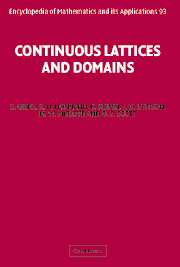Book contents
- Frontmatter
- Contents
- Preface
- Acknowledgments
- Foreword to A Compendium of Continuous Lattices
- Introduction to A Compendium of Continuous Lattices
- O A Primer on Ordered Sets and Lattices
- I Order Theory of Domains
- II The Scott Topology
- III The Lawson Topology
- IV Morphisms and Functors
- V Spectral Theory of Continuous Lattices
- VI Compact Posets and Semilattices
- VII Topological Algebra and Lattice Theory: Applications
- Bibliography
- List of Symbols
- List of Categories
- Index
O - A Primer on Ordered Sets and Lattices
Published online by Cambridge University Press: 13 August 2009
- Frontmatter
- Contents
- Preface
- Acknowledgments
- Foreword to A Compendium of Continuous Lattices
- Introduction to A Compendium of Continuous Lattices
- O A Primer on Ordered Sets and Lattices
- I Order Theory of Domains
- II The Scott Topology
- III The Lawson Topology
- IV Morphisms and Functors
- V Spectral Theory of Continuous Lattices
- VI Compact Posets and Semilattices
- VII Topological Algebra and Lattice Theory: Applications
- Bibliography
- List of Symbols
- List of Categories
- Index
Summary
This introductory chapter serves as a convenient source of reference for certain basic aspects of complete lattices needed in what follows. The experienced reader may wish to skip directly to Chapter I and the beginning of the discussion of the main topic of this book: continuous lattices and domains.
Section O-1 fixes notation, while Section O-2 defines complete lattices, complete semilattices and directed complete partially ordered sets (dcpos), and lists a number of examples which we shall often encounter. The formalism of Galois connections is presented in Section 3. This not only is a very useful general tool, but also allows convenient access to the concept of a Heyting algebra. In Section O-4 we briefly discuss meet continuous lattices, of which both continuous lattices and complete Heyting algebras (frames) are (overlapping) subclasses. Of course, the more interesting topological aspects of these notions are postponed to later chapters. In Section O-5 we bring together for ease of reference many of the basic topological ideas that are scattered throughout the text and indicate how ordered structures arise out of topological ones. To aid the student, a few exercises have been included. Brief historical notes and references have been appended, but we have not tried to be exhaustive.
Generalities and Notation
Partially ordered sets occur everywhere in mathematics, but it is usually assumed that the partial order is antisymmetric. In the discussion of nets and directed limits, however, it is not always so convenient to assume this property.
- Type
- Chapter
- Information
- Continuous Lattices and Domains , pp. 1 - 47Publisher: Cambridge University PressPrint publication year: 2003
- 2
- Cited by



